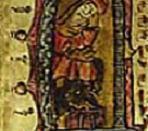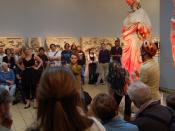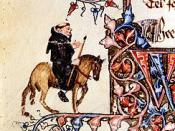Omer Botenski
Survey of English literature from the middle ages to the interregnum
Dr. Aaron Landau
Dec 30th 2012
Comparison of Social Aspects between the Canterbury Tales
and the Vision of Piers Plowman
In the following lines I will try to compare and contrast between Chaucer's "Canterbury Tales" prologue and "The Wife of Bath's Tale" and Langland's "The Vision of Piers Plowman" according to their different representation of English society of their time. I will elaborate about their point of view concerning the various classes in that society: the aristocracy, clergy, peasantry and women, and display open and hidden criticism of them in relation to the writer's own status. The main focus of my essay's first two paragraphs will discuss the prologues of these two estate satires.
Both works has a scene where they present English society by its classes and professions. In Piers Plowman, Langland describes society as "folk" of all classes, and how they are "Working and wandering as the world requires" (18-19), always hanging between the choice Heaven (tower) and Hell (dungeon).
Through lines 20-230, he presents every profession with his characteristics and alignment as he sees it through his eyes. Two very particular examples are the hard working Plowmen which "Won what wasters gluttonously consume" (22) as a positive icon and the pilgrims and palmers which "went on their way with many wise stories" (48), meaning they go abroad with a mantle of holiness and good intentions to uphold God's laws, but the cynical truth is that these men are liars and lazy, roaming the land and living on the expense of hard working people, applying for the role of the "wasters."
I chose these examples because in the Canterbury Tales, Pilgrims are represented in a different light; they provide the entire...


